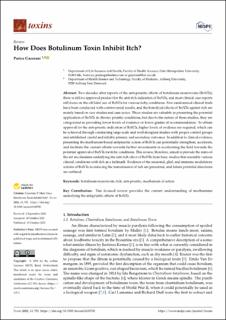| dc.description.abstract | Two decades after reports of the anti-pruritic effects of botulinum neurotoxins (BoNTs), there is still no approved product for the anti-itch indication of BoNTs, and most clinical case reports still focus on the off-label use of BoNTs for various itchy conditions. Few randomized clinical trials have been conducted with controversial results, and the beneficial effects of BoNTs against itch are mainly based on case studies and case series. These studies are valuable in presenting the potential application of BoNTs in chronic pruritic conditions, but due to the nature of these studies, they are categorized as providing lower levels of evidence or lower grades of recommendation. To obtain approval for the anti-pruritic indication of BoNTs, higher levels of evidence are required, which can be achieved through conducting large-scale and well-designed studies with proper control groups and established careful and reliable primary and secondary outcomes. In addition to clinical evidence, presenting the mechanism-based antipruritic action of BoNTs can potentially strengthen, accelerate, and facilitate the current efforts towards further investments in accelerating the field towards the potential approval of BoNTs for itchy conditions. This review, therefore, aimed to provide the state-of-the-art mechanisms underlying the anti-itch effect of BoNTs from basic studies that resemble various clinical conditions with itch as a hallmark. Evidence of the neuronal, glial, and immune modulatory actions of BoNTs in reducing the transmission of itch are presented, and future potential directions are outlined. | en_US |

